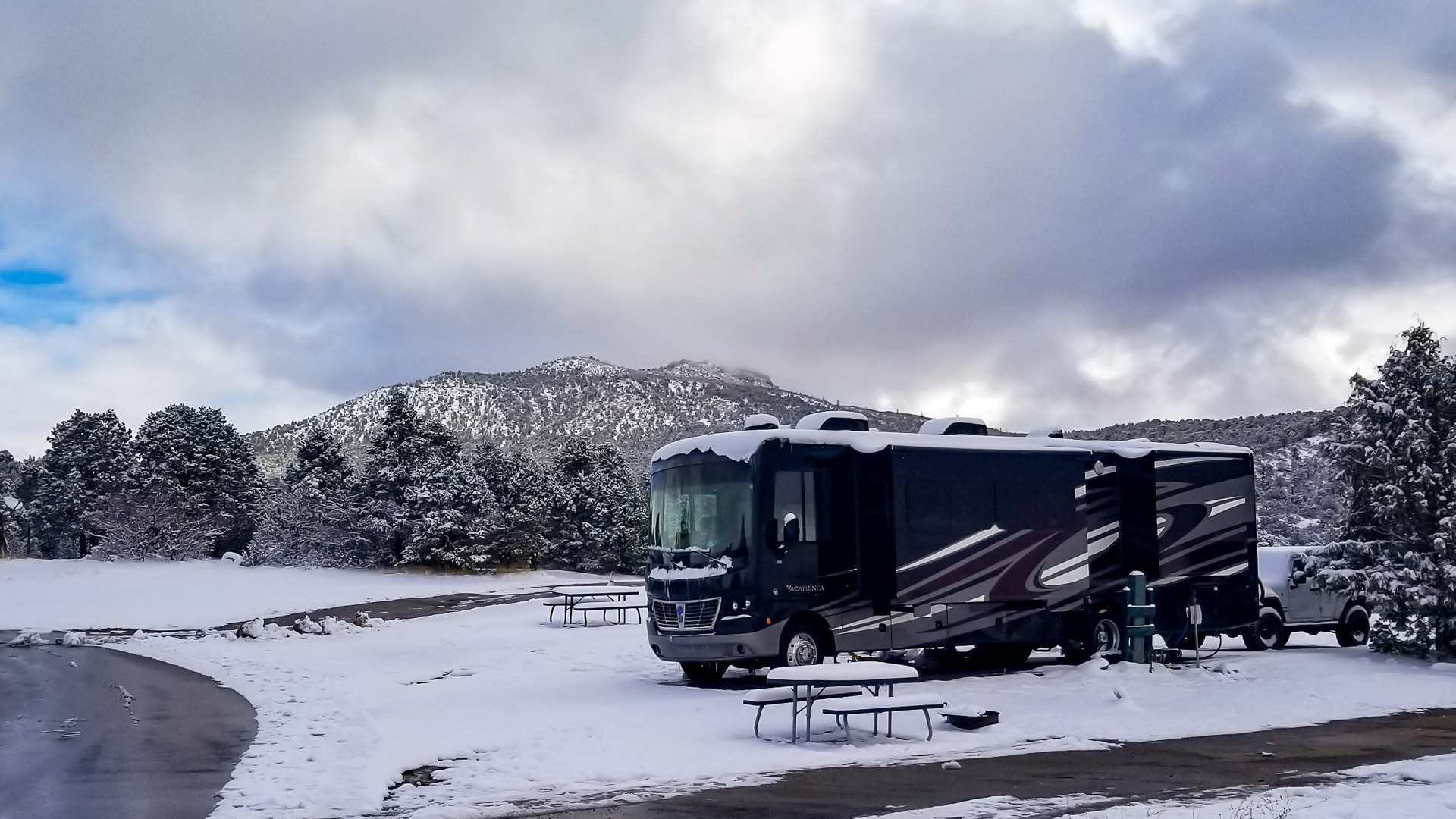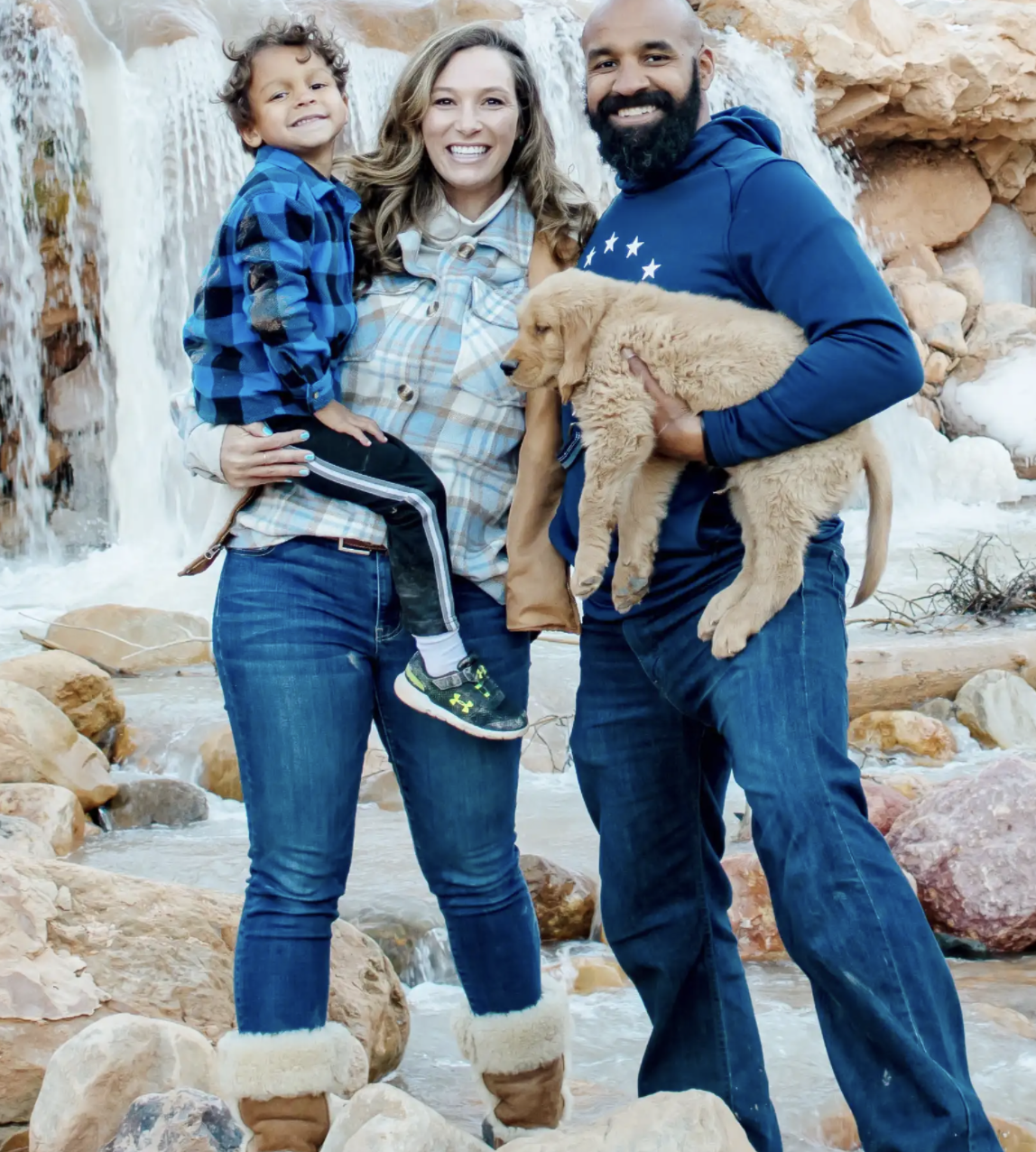
When we decided to live full time on the road, we went against the grain when winter came and chased after snow instead of running from it. Why? Because we love snow! You always hear about the “snowbirds” in the RV community flying south for the winter to find warmer temperatures. But we wanted a white Christmas, so we headed to Park City, Utah, in December to make that happen. Only, it wasn’t exactly the winter wonderland we had in mind. We got to Park City all right, but we only had a few inches of snow the entire month we were there. However, there was no shortage of cold temperatures! And we’re talking subfreezing, chill to the bone, teeth-chattering temperatures. Most nights were in the low teens or single digits, and daily highs rarely got out of the 30s on a good day. So needless to say, we learned a thing or two about cold-weather camping the hard way! In this article, we’re sharing some of the tips and tricks we used to survive RVing in the winter.
You’d probably be surprised by how many people take their campers out when the weather turns cold. After all, enjoying the great outdoors is not only done in the summer! Hitting the slopes, doing some ice fishing, snow tubing or heading out on a hunting trip are a few of the many reasons to brave the winter cold in your rolling chalet. We stayed at an RV resort in Park City through December and January where 60% to 70% of the campsites were full! We definitely saw quite a few tow/towed vehicles come and go with loaded ski racks and a trailer or two with snowmobiles ready to rip. But there were others, like us, who wanted to be in an area for multiple weeks to enjoy its winter season and activities. In any case, there are two major things you will need to be prepared for when venturing out in the cold in your camper. First, you’ll want to focus on keeping yourself warm. And second, but closely related to the first, you’ll need to keep your RV warm, too!
Keeping yourself warm is pretty straightforward. Be sure to pack your warm clothes, layers and any appropriate gear for your favorite winter activities. You’ll also want to have extra blankets for additional warmth when sleeping. And don’t forget the coffee and/or hot chocolate to keep you warm from the inside out. Whether you’re starting your day or capping off an afternoon of snowbound adventures, a good hot beverage is always welcome!
In order to enjoy those warm drinks, however, you’ll need to have water on hand. And if the pipes and tanks in your RV are frozen, then not having coffee isn’t going to be the worst part of your morning. So, let’s talk about keeping that camper warm and functional when the temps dip below freezing. Before you even leave the driveway, check that tire pressure! The pressure drops with the temperature, so be sure to inflate to the recommended PSI before hitting the road. You may also want to load up some tire chains just in case you encounter winter storms on your travels. And be sure to top off your propane tank prior to reaching your destination. You’re going to need it!
Some of the additional prep you’ll want to do depends on the way you will be camping. Are you going for a long weekend or the better part of a month? Or do you live full-time in your rig and want to spend the winter getting as much slope time as possible? Will you be in a campground with hookups, or does being off-grid sound like more your style? Obviously, these variables will determine the amount of effort required to keep your RV (and you) from freezing. Here are the tips we learned from camping in our motor home for a month at a campground with full hookups.
Keeping your pipes and tanks from freezing is crucial to enjoying your trip as it helps you avoid the frustrating process of thawing things out. Trust us, we learned the hard way! It also will help prevent potential water leaks and issues down the road. If your rig has a built-in means of keeping the holding tanks warm, make sure to engage it. Some RVs have electrically heated pads on the tanks, and others, like our 2017 Vacationer, circulate warm air from the furnaces into the lower storage bays and holding tank area. This certainly helps, but alone may not keep your pipes from freezing. The next thing we did was to insulate the water compartment. While the warm air is circulated through from above, the floor of the compartment has no insulation and would ultimately allow the temp inside the compartment to go below freezing when the outside temperature does. So, we took some rigid foam insulation and cut a piece to fit the bottom of the compartment. We also put a small, 250-watt space heater in there to make sure the temp stayed nice and warm. To make sure the water coming into the RV didn’t freeze, we got a Camco heated hose that was worth every penny!

You may find most campgrounds that are open during the winter months ask that you shut off the water and unhook your hose at night. This is a good practice to get into. It’s a bit of a pain to unhook at night and hook back up in the morning, but a frozen spigot is WAY more of a pain to deal with! If you don’t want to bother with shutting the water off every night, you can help prevent the spigot from freezing by getting heat tape and pipe insulation to wrap around the exposed pipe of a frost-free spigot. Don’t skimp on the insulation. Get the thick foam noodle and use more than you think you should. Then throw a thermal bag (insulated grocery bag) over the top, and that should keep enough heat in to prevent freezing.
You can also leave a trickle of water running from a sink to keep water moving and give it less chance to freeze. The drawbacks of this are wasting water and filling your gray tank up too quickly, or worse, overflowing it if you don’t leave the dump valve cracked open. So, this is a technique best used for a shorter trip.

Heating the inside of your rig is the next area you’ll want to focus on. As we mentioned before, bring plenty of warm clothing and some extra blankets to keep you and your family warm. Most likely your RV came equipped with a propane furnace. This is a key reason that it’s important to arrive with a full tank of propane. And depending on the length of your stay, you’ll want to monitor it regularly to make sure you don’t run out. If you’re going for a long weekend, you should be fine. If you have full hookups, you can also run an electric space heater on the inside to keep from using up all your propane.

In our case, we were staying for a month. And on top of that, since we have an A-class motor home, our propane tank is attached and cannot be removed. That means if we need to refill, we have to close up all of our RV slides and drive it to the propane fill station. So, we wanted to stretch our propane as long as possible. Considering our furnace also heats the underneath space where the holding tanks are, we needed to use it periodically to keep them from freezing. But if we used it exclusively, our propane wouldn’t even last a week. So, what we came up with was to use the space heaters inside during the day while the outside temp was above freezing. Then at night, when the temp dropped, we would put the space heater on a light timer. This would cycle the space heater on and off in two-hour increments. When it was off, the furnace would kick on and provide heat inside and underneath. Two hours later, the space heater would kick back on to maintain the temp inside. Rinse and repeat. This worked like a charm, and we were able to stretch our propane tank for three weeks in subfreezing temps!
You can also use heated blankets on the beds to stay comfortable, and that lets you set the thermostat lower than you typically would. If you are off-grid, bring several extra propane tanks and set your thermostat as low as you can bear. Depending on how long your trip is, you’ll need that propane to last!
If you’re going to be in one spot for the whole winter season, there are some additional measures you can take to insulate your rig. You can skirt your RV and run heat lamps underneath. The skirting keeps air from moving underneath your RV, and the heat lamps keep the air inside the skirting warm, along with your tanks and water lines. You can also put insulating film over your windows as they are most likely the greatest areas of heat loss. Lastly, you can wrap your slideouts in 2-inch rigid foam. This is a tedious process, but for a long-term stay, it will make a huge difference in keeping the heat inside your RV from escaping too quickly.
Camping in the winter is really fun and gives you the opportunity to enjoy the outdoors in a different way. And as long as you can keep everything warm and cozy, you’ll have a blast. Happy camping!





